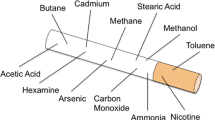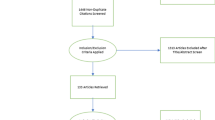Abstract
Purpose
This review was written to analyse the potential role of the cholinergic anti-inflammatory pathway in smoking-induced impairment of the bone healing process.
Methods
Literature in PubMed was reviewed by entering the following keywords “smoking AND bone healing”, “cholinergic anti-inflammatory pathway AND tumour necrosis factor”, “tumour necrosis factor AND bone healing”. All the related papers were recruited and carefully selected according to the content of this paper.
Results
Literature review indicated that tumour necrosis factor alpha (TNF-α) plays a pivotal role in the fracture healing process. In brief, TNF-α may accelerate the endochondral ossification process by increasing matrix metalloproteinases (MMPs) level, chondrocyte apoptosis, as well as osteoclast formation, therefore reducing the cartilaginous stage leading to the acceleration of fracture healing. Nicotine is the main effective ingredient of tobacco, which has been found to inhibit the secretion of TNF-α through activation of the cholinergic anti-inflammatory pathway.
Conclusions
It is reasonable to believe that the nicotine in tobacco at least partly contributes to the delayed fracture healing by inhibiting TNF-α secretion through the activation of the cholinergic anti-inflammatory pathway. An in-depth study of this issue will contribute to the clinical treatment of nonunion, as well as the development of new therapies to accelerate bone healing.

Similar content being viewed by others
References
Aizawa T, Kon T, Einhorn TA, Gerstenfeld LC (2001) Induction of apoptosis in chondrocytes by tumor necrosis factor-alpha. J Orthop Res 19:785–796
Alblowi J, Kayal RA, Siqueria M, McKenzie E, Krothapalli N, McLean J, Conn J, Nikolajczyk B, Einhorn TA, Gerstenfeld L, Graves DT (2009) High levels of tumor necrosis factor-alpha contribute to accelerated loss of cartilage in diabetic fracture healing. Am J Pathol 175:1574–1585
Bartecchi CE, MacKenzie TD, Schrier RW (1995) The global tobacco epidemic. Sci Am 272:44–51
Birnstingl MA, Brinson K, Chakrabarti BK (1971) The effect of short-term exposure to carbon monoxide on platelet stickiness. Br J Surg 58:837–839
Cho TJ, Lehmann W, Edgar C, Sadeghi C, Hou A, Einhorn TA, Gerstenfeld LC (2003) Tumor necrosis factor alpha activation of the apoptotic cascade in murine articular chondrocytes is associated with the induction of metalloproteinases and specific pro-resorptive factors. Arthritis Rheum 48:2845–2854
de Jonge WJ, Ulloa L (2007) The alpha7 nicotinic acetylcholine receptor as a pharmacological target for inflammation. Br J Pharmacol 151:915–929
de Jonge WJ, van der Zanden EP, The FO, Bijlsma MF, van Westerloo DJ, Bennink RJ, Berthoud HR, Uematsu S, Akira S, van den Wijngaard RM, Boeckxstaens GE (2005) Stimulation of the vagus nerve attenuates macrophage activation by activating the Jak2-STAT3 signaling pathway. Nat Immunol 6:844–851
Fu X, Han B, Cai S, Lei Y, Sun T, Sheng Z (2009) Migration of bone marrow-derived mesenchymal stem cells induced by tumor necrosis factor-alpha and its possible role in wound healing. Wound Repair Regen 17:185–191
Gerstenfeld LC, Cho TJ, Kon T, Aizawa T, Cruceta J, Graves BD, Einhorn TA (2001) Impaired intramembranous bone formation during bone repair in the absence of tumor necrosis factor-alpha signaling. Cells Tissues Organs 169:285–294
Gerstenfeld LC, Cho TJ, Kon T, Aizawa T, Tsay A, Fitch J, Barnes GL, Graves DT, Einhorn TA (2003) Impaired fracture healing in the absence of TNF-alpha signaling: the role of TNF-alpha in endochondral cartilage resorption. J Bone Miner Res 18:1584–1592
Giebelen IA, van Westerloo DJ, LaRosa GJ, de Vos AF, van der Poll T (2007) Local stimulation of alpha7 cholinergic receptors inhibits LPS-induced TNF-alpha release in the mouse lung. Shock 28:700–703
Kosaki N, Takaishi H, Kamekura S, Kimura T, Okada Y, Minqi L, Amizuka N, Chung UI, Nakamura K, Kawaguchi H, Toyama Y, D'Armiento J (2007) Impaired bone fracture healing in matrix metalloproteinase-13 deficient mice. Biochem Biophys Res Commun 354:846–851
Krannitz KW, Fong HW, Fallat LM, Kish J (2009) The effect of cigarette smoking on radiographic bone healing after elective foot surgery. J Foot Ankle Surg 48:525–527
Lehmann W, Edgar CM, Wang K, Cho TJ, Barnes GL, Kakar S, Graves DT, Rueger JM, Gerstenfeld LC, Einhorn TA (2005) Tumor necrosis factor alpha (TNF-alpha) coordinately regulates the expression of specific matrix metalloproteinases (MMPS) and angiogenic factors during fracture healing. Bone 36:300–310
Majka S, McGuire PG, Das A (2002) Regulation of matrix metalloproteinase expression by tumor necrosis factor in a murine model of retinal neovascularization. Invest Ophthalmol Vis Sci 43:260–266
Polzer K, Schett G, Zwerina J (2007) The lonely death: chondrocyte apoptosis in TNF-induced arthritis. Autoimmunity 40:333–336
The FO, Boeckxstaens GE, Snoek SA, Cash JL, Bennink R, Larosa GJ, van den Wijngaard RM, Greaves DR, de Jonge WJ (2007) Activation of the cholinergic anti-inflammatory pathway ameliorates postoperative ileus in mice. Gastroenterology 133:1219–1228
Tracey KJ (2002) The inflammatory reflex. Nature 420:853–859
van Maanen MA, Lebre MC, van der Poll T, LaRosa GJ, Elbaum D, Vervoordeldonk MJ, Tak PP (2009) Stimulation of nicotinic acetylcholine receptors attenuates collagen-induced arthritis in mice. Arthritis Rheum 60:114–122
Waldburger JM, Boyle DL, Pavlov VA, Tracey KJ, Firestein GS (2008) Acetylcholine regulation of synoviocyte cytokine expression by the alpha7 nicotinic receptor. Arthritis Rheum 58:3439–3449
Walker JG, Smith MD (2005) The Jak-STAT pathway in rheumatoid arthritis. J Rheumatol 32:1650–1653
Wang H, Yu M, Ochani M, Amella CA, Tanovic M, Susarla S, Li JH, Wang H, Yang H, Ulloa L, Al-Abed Y, Czura CJ, Tracey KJ (2003) Nicotinic acetylcholine receptor alpha7 subunit is an essential regulator of inflammation. Nature 421:384–388
Acknowledgement
This research was supported by the National Natural Science Foundation of China (support number: 81000786).
Author information
Authors and Affiliations
Corresponding author
Rights and permissions
About this article
Cite this article
Chen, Y., Guo, Q., Pan, X. et al. Smoking and impaired bone healing: will activation of cholinergic anti-inflammatory pathway be the bridge?. International Orthopaedics (SICOT) 35, 1267–1270 (2011). https://doi.org/10.1007/s00264-011-1243-5
Received:
Accepted:
Published:
Issue Date:
DOI: https://doi.org/10.1007/s00264-011-1243-5




